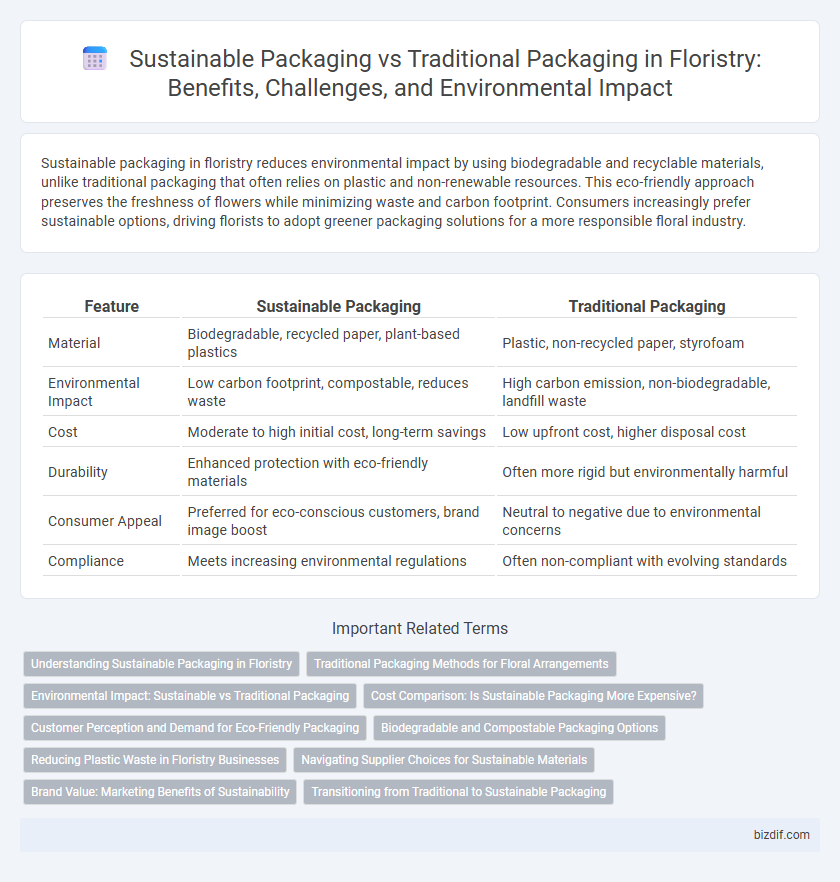Sustainable packaging in floristry reduces environmental impact by using biodegradable and recyclable materials, unlike traditional packaging that often relies on plastic and non-renewable resources. This eco-friendly approach preserves the freshness of flowers while minimizing waste and carbon footprint. Consumers increasingly prefer sustainable options, driving florists to adopt greener packaging solutions for a more responsible floral industry.
Table of Comparison
| Feature | Sustainable Packaging | Traditional Packaging |
|---|---|---|
| Material | Biodegradable, recycled paper, plant-based plastics | Plastic, non-recycled paper, styrofoam |
| Environmental Impact | Low carbon footprint, compostable, reduces waste | High carbon emission, non-biodegradable, landfill waste |
| Cost | Moderate to high initial cost, long-term savings | Low upfront cost, higher disposal cost |
| Durability | Enhanced protection with eco-friendly materials | Often more rigid but environmentally harmful |
| Consumer Appeal | Preferred for eco-conscious customers, brand image boost | Neutral to negative due to environmental concerns |
| Compliance | Meets increasing environmental regulations | Often non-compliant with evolving standards |
Understanding Sustainable Packaging in Floristry
Sustainable packaging in floristry emphasizes the use of biodegradable, recyclable, and compostable materials that reduce environmental impact and promote eco-friendly practices. This approach minimizes plastic waste and lowers carbon footprint compared to traditional packaging like non-recyclable plastics and foam. Florists adopting sustainable packaging support conservation efforts while enhancing their brand's eco-conscious reputation.
Traditional Packaging Methods for Floral Arrangements
Traditional packaging methods for floral arrangements typically involve the use of plastic wraps, foam blocks, and non-biodegradable ribbons, which often contribute to significant environmental waste. These conventional materials lack eco-friendly properties and are frequently discarded after a single use, increasing landfill accumulation. Despite affordability and widespread availability, traditional packaging poses challenges for sustainability within the floristry industry.
Environmental Impact: Sustainable vs Traditional Packaging
Sustainable packaging in floristry significantly reduces environmental impact by utilizing biodegradable, compostable, and recyclable materials that minimize waste and pollution. Traditional packaging often relies on plastics and non-renewable resources, contributing to landfill accumulation and increased carbon emissions. Choosing sustainable options supports ecosystem preservation and promotes a circular economy within the floral industry.
Cost Comparison: Is Sustainable Packaging More Expensive?
Sustainable packaging often has a higher upfront cost compared to traditional packaging due to the use of eco-friendly materials such as recycled paper, biodegradable plastics, and plant-based fibers. However, long-term savings can be achieved through reduced waste management fees and positive brand reputation, which can attract eco-conscious customers and increase sales. Florists must weigh initial costs against environmental benefits and potential market advantages when choosing sustainable packaging solutions.
Customer Perception and Demand for Eco-Friendly Packaging
Customers increasingly view sustainable packaging as a crucial factor when selecting floristry products, associating it with environmental responsibility and brand ethics. Demand for eco-friendly packaging in floristry has surged, driven by growing awareness of plastic waste and preference for biodegradable, recyclable materials. This shift influences purchasing decisions, with many consumers willing to pay a premium for floral arrangements wrapped in sustainable packaging solutions.
Biodegradable and Compostable Packaging Options
Biodegradable and compostable packaging options in floristry significantly reduce environmental impact compared to traditional plastic packaging by breaking down naturally and enriching soil without leaving harmful residues. Materials such as cornstarch-based films, recycled paper, and bamboo fibers offer sustainable alternatives that maintain flower freshness while minimizing landfill waste. Adopting these eco-friendly solutions supports sustainable floristry practices and meets consumer demand for environmentally responsible products.
Reducing Plastic Waste in Floristry Businesses
Sustainable packaging in floristry significantly reduces plastic waste by utilizing biodegradable materials such as recycled paper, plant-based cellophane, and compostable wraps, replacing traditional plastic-based products. Floristry businesses adopting sustainable packaging not only minimize environmental impact but also strengthen their brand appeal to eco-conscious consumers. Transitioning to these eco-friendly alternatives cuts down on landfill waste and promotes a circular economy within the floral industry.
Navigating Supplier Choices for Sustainable Materials
Choosing sustainable packaging in floristry involves prioritizing suppliers who offer biodegradable, recycled, or compostable materials such as kraft paper, bamboo fiber, and plant-based plastics. Traditional packaging often relies on non-renewable plastics and synthetic coatings that increase environmental impact and landfill waste. Evaluating supplier certifications, sourcing transparency, and material lifecycle data helps florists make informed decisions aligning with eco-friendly business practices.
Brand Value: Marketing Benefits of Sustainability
Sustainable packaging enhances brand value by demonstrating a florist's commitment to environmental responsibility, attracting eco-conscious customers and differentiating the business in a competitive market. Incorporating biodegradable or recyclable materials reduces carbon footprint and aligns with growing consumer demand for ethical practices, boosting brand loyalty. Traditional packaging often lacks these marketing benefits, making sustainable alternatives a strategic choice for long-term brand equity.
Transitioning from Traditional to Sustainable Packaging
Transitioning from traditional to sustainable packaging in floristry reduces plastic waste and lowers the carbon footprint by utilizing biodegradable materials such as recycled paper, cornstarch, and plant-based plastics. Sustainable packaging enhances brand reputation and meets growing consumer demand for eco-friendly practices while supporting circular economy principles. Adopting sustainable solutions also improves supply chain efficiency by minimizing material use and enabling easier recycling or composting of floral packaging waste.
Sustainable packaging vs traditional packaging Infographic

 bizdif.com
bizdif.com